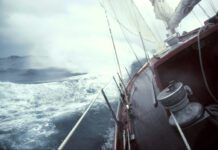Back in 1992, a friend of ours competed in the OSTAR (Observer Single-handed Transatlantic Race). Onboard electrical demands, especially from electronics, had recently grown, and he needed a charging source other than the engine. Marine wind generators were still unproven and solar panels were prohibitively expensive.
A group of us got together and bought for him a towed waterpowered generator for charging his batteries. He came back with good stories of how much electricity it produced—but alas, he lost the boat and generator 500 miles from the finish, so we never got a chance to try it ourselves.
The past decade has brought only greater demand for electrical power. That demand has made wind-powered generators commonplace and solar panel technology far less costly. In addition to the engine’s alternator, these are the most common charging sources for a boat at anchor or underway. However, we rarely hear anything about towed water-powered generators. Always on the prowl for alternative energy sources, we decided to try for ourselves a towed generator on a cruise from the US East Coast to Bermuda and back last summer.
HOW IT WORKS
The technology behind the towed generator is simple to understand. Its principle is very similar to the old Walker Log. As you sail, you tow behind the boat a spinning propeller on a long line that resists twisting. On the boat end of the line is a generator. As the boat moves through the water, the propeller spins, and the twist-resistant line transfers that spinning directly to the generator, which generates electricity. The faster the boat moves through the water, the more electricity is generated.
It’s worth remembering that it’s the movement of the boat through the water that turns the spinner, not the boat’s speed over the bottom. If a boat were anchored in a strong enough current with the towed generator behind, it could generate power. In this way, homesteaders living “off the grid” can make use of waterpowered generators if they live next to a fast-moving stream.
For more information on hydro generators, purchase Marine Electrical Systems, Vol. 4: Alternative Energy. Or, buy the entire Marine Electrical Systems six-part series!








































